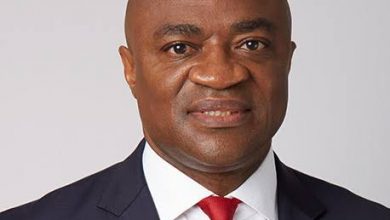FBN Holdings Plc: Interest Income to Propel FY 2025 Earnings

Aided by a stronger Net Interest Margin (NIM) (+1.0ppt YoY) and higher fair value gains on financial instruments, FBNH reported a 2.1x surge in operating income to N1.5trn in 9M’24. This impressive operating income print highlights the impact of a 76.3% YoY expansion in interest-earning assets (IEA) to N19.3trn and a 3.2ppts increase in asset yields that aligns with the elevated interest rate environment.
Hence, accounting for these improved gains and broadly stable core drivers, we revise our gross earnings and PAT projections to N3.1trn and N734.0bn, respectively. For profitability metrics, we see scope for higher ROA of 3.1% (FY 2023: 2.3%) and ROE of 31.6% (FY 2023: 22.6%).
In FY 2025, we expect PAT to improve by a milder c.17.1% YoY due to the high base created by FY 2024. This expectation is hinged on tamer Net Interest Income (NII) growth (+36.6% YoY compared to 123.44% in FY 2024) and moderation in FX-related income as currency pressure eases. We remain optimistic about the bank’s ability to accrue benefits from the high-interest rate environment for NII. Nevertheless, the potential rate cuts in H2 2025 may place a cap on NII growth.
Prominent Interest Income to Remain Prevalent
In line with our position, the 41.2% Naira depreciation over 9M 2024 significantly contributed to the 149.3% YoY increase in IEA, with gross loans expanding by 48.0% YTD and investment securities surging 139.0% YTD. We also observed the increasing importance of interest income from investment securities in the gross earnings mix, given that it is the only sub-component to have more than doubled its contribution between FY 2022 and 9M 2024. As can be seen from Figure 1, contributions from non-interest income and interest income on loans and advances both contracted by 5.2ppts and 7.7ppts to 27.2% and 48.8%, respectively. Given heightened macroeconomic and business risk environments, this pattern may be consistent with the need to gravitate towards attractive, risk-free government fixed-income instruments and be cautious in fund allocation.
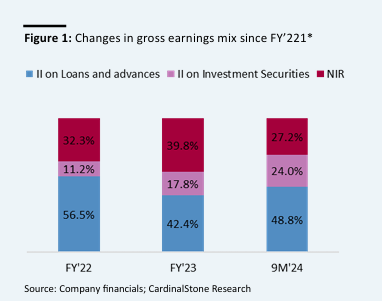
For FY 2025, we expect the gross earnings mix to continue to emphasize the growing contribution of interest income on investment securities despite an expected modest moderation (sub 200bps) in monetary policy rate in the second half of 2025 that should still leave short-term interest rates at attractive levels. Elsewhere, IEA growth is likely to materially slow because of tamer Naira devaluation and modest loan growth of 20.0% (vs a 3-year average of 43.7%). Asset yields are also expected to moderate, in line with the expected change in monetary policy direction in H2 2025. Therefore, NIM should moderate to 7.4% (vs 7.7% in FY 2024E), despite the expected moderation in Cost of Funds (CoF).
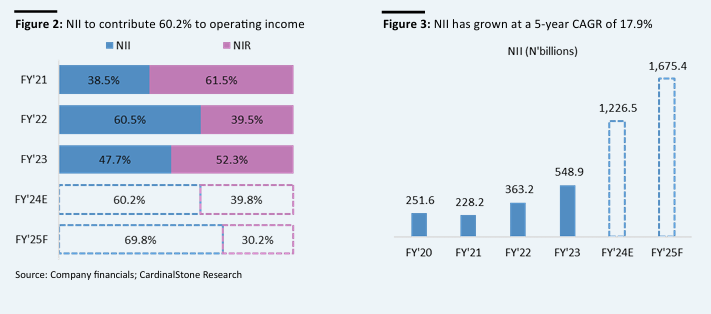
NIR’s Contribution to Operating Income to Moderate To 39.8%
In FY 2024, we maintain that NIR (+34.6% YoY to N810.1bn) will play a secondary role in driving operating income with a contribution of 39.8%. The view is underpinned by the forecasted milder increase in gains from fair value through profit or loss (FVTPL) versus NII, given an expected more subtle passthrough of Naira devaluation on gains from derivative contracts.
We recall that in 9M 2024, the impact of the currency devaluation on FBNH’s net-short FCY position led to a foreign exchange revaluation loss of N264.4bn (a 2.2x increase from 9M 2023). Nevertheless, the N551.8bn in net gains from financial instruments at FVTPL offset this loss, which resulted from the revaluation of FBNH’s N597.02bn derivative contracts. Overall, net FX-related income grew by 121.1% to N325.0bn (9M 2023: N147.0bn), underscoring the robustness of fair value gains from FVTPL.
Further out, the expected relative currency stability in FY 2025 will likely curtail the income growth from derivatives contract revaluation. Hence, we expect fees and commission income, particularly from letters of credit commissions and electronic banking fees, to emerge as key drivers of FBNH’s NIR.
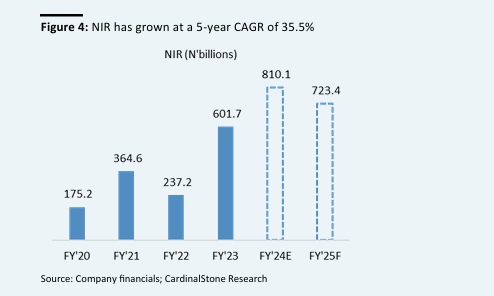
Asset Quality to Remain Healthy
As of 9M 2024, loans extended to the oil and gas sector accounted for c.49.0% of FBNH‘s loan portfolio and represented 14.6% of its NPLs (vs 27.3% in FY’23). Given that loans within this sector are typically priced in foreign currency and the significant currency devaluation in 9M 2024, the moderation in the weight of oil & gas NPLs is encouraging, also, despite the heightened operating difficulties from the manufacturing sector, displayed by the less than 1.0% growth in manufacturing GDP for Q3 2024, the sector’s contribution to NPLs only marginally increased by 10bps to 1.1%.
We estimate this is linked to the 2.2ppts decline in the proportion of manufacturing sector allocation to total loans, as the bank proactively reduced its exposure to this high-risk segment.
Overall, following the bank’s extensive balance sheet cleanup and renewed risk management efforts, we expect NPLs to remain below 5.0% (FY 2024E 4.4% vs FY 2023: 4.8%) with an NPL coverage of c.82.0% (vs. 85.3% in FY 2023). The expectation is hinged on our projection for a milder 56.0% increase in stage 3 loans in FY 2024E, compared to the more significant 103.5% increase in stage 3 loan loss allowance as of 9M 2024.
Capital Raise Activities Essential For CAR
Following shareholders’ approval at its 11th AGM, FBNH is currently in the capital market seeking to raise N150bn to support the capitalization and business expansion of its banking subsidiary- First Bank of Nigeria Limited.
At the 12th AGM, shareholders also approved raising up to N350bn through various equity transactions, subject to regulatory approval, to support growth, enhance resilience, increase shareholder value, and meet Basel III requirements.
We idealize that upon the completion of the capital raise, FBNH’s capital adequacy ratio (CAR) should receive a sufficient boost, increasing the CAR above its 3-year mean of 17.4%.
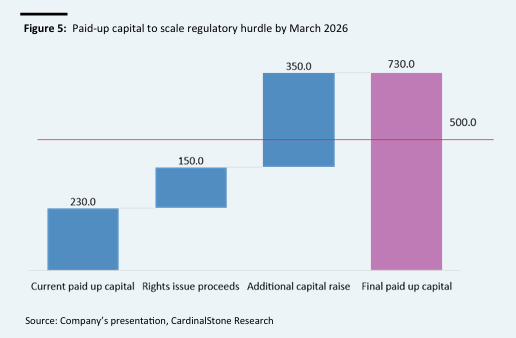
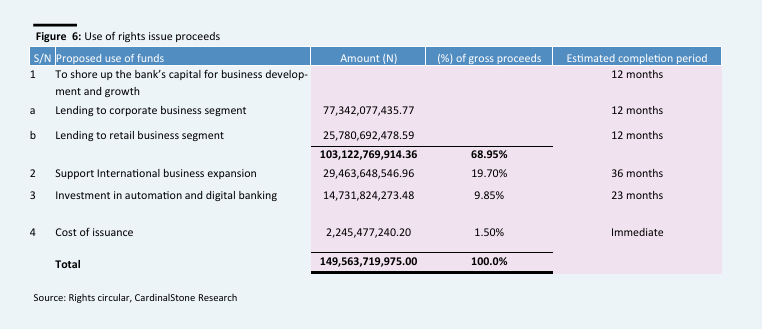
Adjustments To Our Model Related to the Rights Issue Program
Given the commencement of the rights issue program, we have made the following adjustments to our forecasts.
1. We assumed the rights issue program was fully subscribed, and N149,563,719,975 was raised.
2. We estimate a weighted average number of shares for FY 2025 at 40.38bn and the total outstanding shares for FY 2026 and other financial years at c.41.88bn pending the activation of other capital raise phases.
3. We assume that the bank will receive the funds after the regulatory process at the end of Q1 2025.
4. We have estimated an N2.99bn increase in share capital (i.e. 50 kobo multiplied by c.5.9bn shares.
5. We have estimated a N146.57bn increase in share premium (i.e. (N25.0 – 50 kobo) multiplied by c.5.9bn shares).
Valuation
Revisions to our model have yielded a new 12-month Target Price (TP) of N27.58, representing a 13.1% reduction from the previously communicated TP of N31.75 and a HOLD recommendation on the ticker. This downward adjustment reflects the dilutive impact of the additional 5,982,548,799 shares issued via rights issue. Notably, if the total shares outstanding were held constant, our 12-month TP for FBNH would be N32.27.
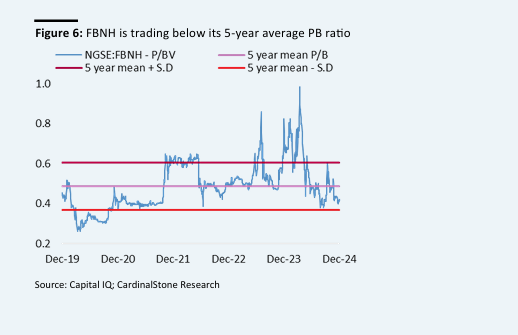
For further updates on FBN Holdings Plc, follow the company Proshare Investor Relations (IR) Portal.

